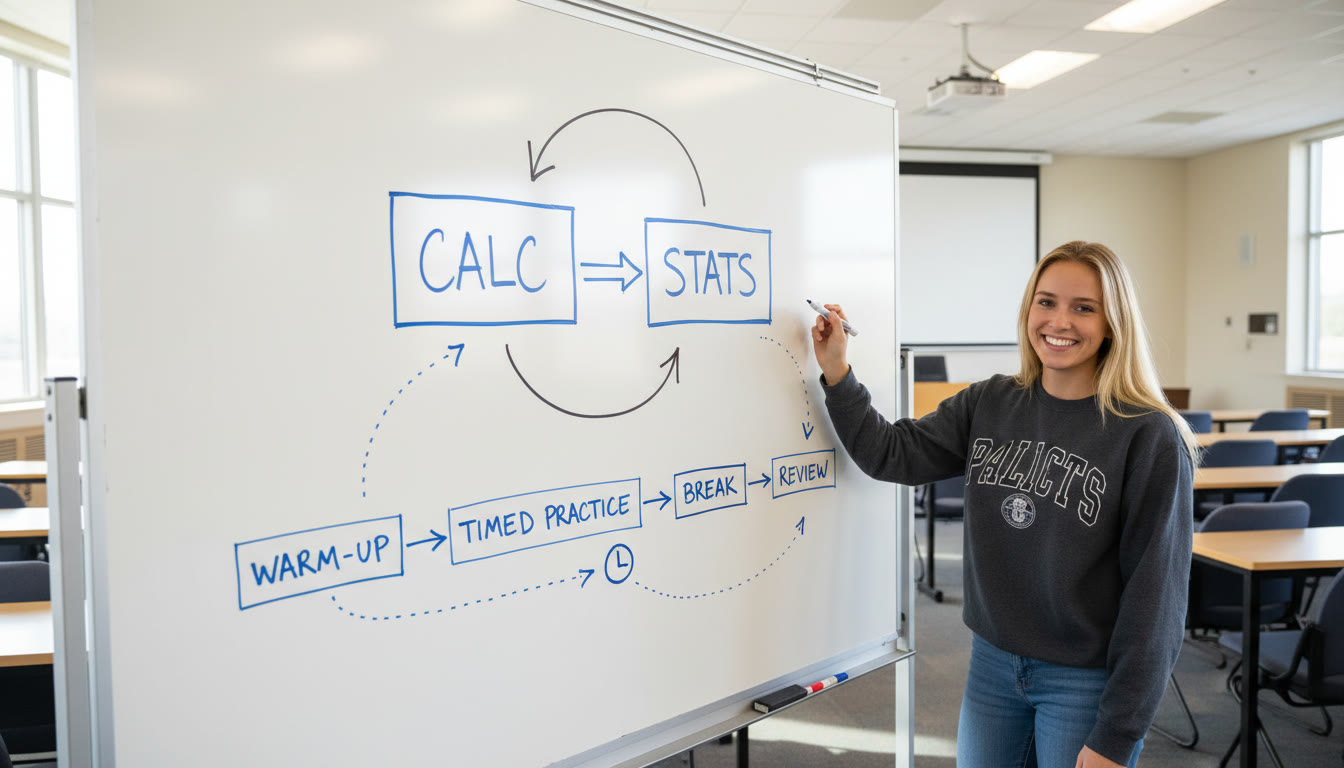Why a Mixed FRQ Day Works — and Why You’ll Love It
Let’s be honest: studying in silos can make your brain expect the same type of problem over and over. Doing a mixed FRQ (Free-Response Question) day — alternating between AP Calculus and AP Statistics prompts — trains your mind to switch gears quickly, spot what’s being asked, and apply the right set of tools under pressure. This isn’t about gimmicks; it’s deliberate practice that mirrors the way tests actually feel. You’ll build endurance, sharpen time management, and reduce the surprise factor on exam day.

Who This Plan Is For
This guide is built for upper-level high school students preparing for AP Calculus AB/BC and AP Statistics FRQs. Whether you’re balancing both classes, retaking an exam, or aiming for a higher score, the mixed FRQ day helps you simulate test conditions and learn how to recover quickly when you stumble.
How to Structure a Mixed FRQ Day
We’ll walk through a practical, timed schedule that you can adapt for full or half study days. The goal is to practice with focus and reflection, not just to grind problems.
Suggested Full-Day Schedule (6 hours)
- 0:00–0:30 — Warm-up & goal setting (concept review, formula sheet check)
- 0:30–1:20 — Calc FRQ Set A (timed, simulate exam conditions)
- 1:20–1:40 — Short break and self-check (quick review of attempted answers)
- 1:40–2:30 — Stats FRQ Set A (timed)
- 2:30–3:15 — Lunch and full break (mental reset)
- 3:15–4:05 — Calc FRQ Set B (targeted weakness practice)
- 4:05–4:25 — Break + reflection
- 4:25–5:15 — Stats FRQ Set B (apply alternate strategies)
- 5:15–6:00 — Review, annotate errors, plan next steps
Half-Day Option (3 hours)
- 0:00–0:20 — Quick warm-up
- 0:20–1:00 — Calc FRQ set (timed)
- 1:00–1:15 — Break + micro-reflection
- 1:15–1:55 — Stats FRQ set (timed)
- 1:55–3:00 — Deep review and note-making
Warm-Up: The 10-Minute Prep That Changes Everything
Before you dive into timed FRQs, prime your brain. Ten minutes of targeted warm-up increases accuracy and reduces careless mistakes.
- Skim formulas and key theorems: derivatives, integrals, sampling distributions, confidence interval formulas.
- Do one micro-problem from each discipline: a derivative rule and a short probability question.
- Set intention: choose two measurable goals for the session (e.g., “no arithmetic errors on calc problem 2” or “write a full interpretation sentence for every stats part c”).
Timed Practice: How to Run Effective FRQ Sets
Simulating the exam environment helps you learn pacing and pressure management. Here’s a method that balances realism with useful reflection.
Step-by-step Timed Run
- Choose 2–3 FRQs from recent practice materials. Aim for a mix: conceptual, computational, and interpretation.
- Clear your workspace, set a timer, and stick to the time limits you’ll have on the real AP (or slightly shorter to add difficulty).
- Write full explanations for Stats: even if you know the numeric answer, the AP wants interpretation. For Calc, show key steps and justify methodology.
- When time’s up, stop. Resist the urge to finish; this helps train realistic pacing.
Smart Review: The Difference Between Doing and Improving
Review is where the magic happens. Many students do FRQs repeatedly but don’t adopt a system for reflection. Here’s one that works.
Five-Minute Error Audit
- Classify each mistake: Conceptual, Computation, Notation, or Time-Driven.
- Write a one-line correction for each error. If it’s conceptual, write the underlying rule that would prevent it.
- Mark any recurring patterns in your notebook — these become your targeted drills.
Deep Fix: Rework Without a Timer
After the quick audit, pick the toughest problem you missed and rework it untimed. Explain each step as if you’re teaching someone. This cements deeper understanding and builds the habit of clear explanations — a scoring advantage on FRQs.
Practical Strategies for Calculus FRQs
Calculus FRQs test your ability to connect concepts, not just grind derivatives. Use these strategies every time.
- Read the entire problem before writing. Many FRQs have later parts that inform earlier assumptions.
- Annotate diagrams and labels: mark critical points, intervals of interest, and units.
- When asked for approximations, indicate method (e.g., “using Simpson’s Rule”) and show setup — partial credit lives here.
- Keep an eye on units: rates, distances, and times should be consistent and labeled.
Common Pitfalls and Quick Fixes (Calc)
- Misreading difference between derivative and integral — underline the operation in the prompt.
- Dropping negative signs in algebra steps — slow down on sign-heavy manipulations, annotate each rearrangement.
- For related rates: write what’s given, what’s asked, and the primary equation connecting variables before differentiating.
Practical Strategies for Statistics FRQs
AP Statistics FRQs reward clarity in interpretation more than perfect arithmetic. Clarity and context are your friends.
- Always include a phrase explaining what the numeric result means in context (e.g., “We are 95% confident that the true mean… “).
- When using sample statistics, state assumptions (random sampling, independence, normality when relevant).
- Round intermediate steps sensibly but present a final answer with correct precision and units.
- For hypothesis tests, always list hypotheses, test statistic, p-value or critical value, and conclude in context.
Common Pitfalls and Quick Fixes (Stats)
- Confusing correlation with causation — explicitly state whether causation can be inferred.
- For confidence intervals, forgetting to check conditions — list them briefly in your answer.
- Misreporting p-values — write whether p is “less than” or “greater than” a significance level and give the interpretation.
Worked Example Pair: One Calculus FRQ + One Stats FRQ
Below are compact worked outlines you can model. These are not full AP answers but show structure and clarity.
Calc Example (Outline)
Prompt theme: area between curves and interpretation of a definite integral.
- Step 1 — Sketch region and set up integral(s) with bounds: show explicit limits and integrand.
- Step 2 — Evaluate integral or set up for numerical method; show key antiderivative steps.
- Step 3 — Interpret: link the computed area or value to units/context given in the problem.
Stats Example (Outline)
Prompt theme: hypothesis test for a population mean with an unknown sigma.
- Step 1 — State H0 and Ha in words and symbols.
- Step 2 — Check conditions: random sample, approximate normality or large n, independence.
- Step 3 — Compute t-statistic, degrees of freedom, and p-value (or compare to critical t).
- Step 4 — Conclude in context and suggest practical significance if relevant.
Data Table: Quick Reference for Common FRQ Actions
| Task | Calc Tactic | Stats Tactic |
|---|---|---|
| Set up integral or formula | Label bounds, show integrand | Identify statistic, show formula with sample values |
| Show work for partial credit | Display intermediate antiderivative/simplification | Show test statistic calculation, assumptions |
| Interpretation | Relate result to units and original variable | Write sentence translating numeric result into real-world meaning |
| Common error | Sign errors and bounds confusion | Misreading whether significance implies practical importance |
Building Recovery Habits: What To Do After a Tough FRQ
We all hit a wall. The difference between students who improve and those who plateau is not IQ — it’s recovery strategy.
- Take a 10–15 minute break to disengage: walk, stretch, hydrate.
- Return and re-attempt the problem slowly, writing each step and narrating your reason out loud if possible.
- If stuck on a concept, flag it and schedule a focused mini-lesson (15–30 minutes) later in the week.
Tracking Progress: Your Mini Data Dashboard
Keep a simple log to know if your practice is working. Track the following after each mixed FRQ day:
- Number of FRQs attempted (Calc / Stats)
- Percent complete within time
- Top two recurring errors
- One thing to fix next session
Example entry:
| Date | Calc FRQs | Stats FRQs | Recurring Errors | Next Focus |
|---|---|---|---|---|
| Oct 7, 2025 | 3 | 2 | Sign errors; weak CI interpretation | Targeted algebra practice; write 5 CI sentences |
How to Use Personalized Tutoring to Amplify Mixed FRQ Days
Working with an experienced tutor (or a personalized tutoring platform) accelerates the feedback loop. A skilled tutor can spot patterns you don’t see, provide a tailored study plan, and coach you on writing crisp FRQ responses — the kind graders love.
If you choose to integrate one-on-one help, look for these benefits: adaptive study plans, focused time on weak concepts, model responses, and targeted feedback on timing and presentation. For students using Sparkl’s personalized tutoring, for example, the one-on-one guidance and AI-driven insights can be particularly effective in turning a mixed FRQ day into measurable score improvements. Tutors can design drills specifically for the errors you log and help you rehearse full exam pacing.
Session Templates You Can Reuse
Save these templates into your study planner. They make setting up a mixed FRQ day fast and repeatable.
Template A — Speed Focus
- Warm-up: 10 minutes
- 2 Calc FRQs timed at 80% of test time
- 2 Stats FRQs timed at 80% of test time
- Quick audit and one deep rework
Template B — Depth Focus
- Warm-up: 15 minutes
- 1 hard Calc FRQ untimed
- 1 hard Stats FRQ untimed
- 45 minutes review with a tutor or study partner
Practical Tips to Keep Your Mind Sharp on Mixed Days
- Hydrate and fuel: working memory loves steady glucose — prefer whole-food snacks over sugary spikes.
- Switch modalities: alternate between writing by hand and typing (if you normally handwrite, try reading typed solutions aloud to vary input).
- Use a single question notebook: keep an index so you can quickly re-find problems you struggled with.
- Sleep matters: review sessions are exponentially more effective after a good night’s rest.

Final Checklist: Your Mixed FRQ Day Starter Pack
- Timer with configurable intervals
- Formula sheet and graphing calculator (charged and cleared)
- Printed FRQs or a clean PDF for annotation
- Study log notebook or digital tracker
- A plan for follow-up (tutor session, focused drill, or next mixed day)
One-Week Mixed FRQ Microcycle (Example)
Don’t just do a single mixed day and hope for miracles. Use a weekly cycle that alternates speed and depth.
| Day | Focus | Activity |
|---|---|---|
| Monday | Speed | Short warm-up + 2 Calc + 2 Stats timed at 75% speed |
| Wednesday | Depth | 1 untimed Calc + 1 untimed Stats; deep reworks |
| Friday | Mix & Review | 3 mixed FRQs under exam timing; log errors and plan weekend drills |
Words of Encouragement
Improvement doesn’t always look linear. Some weeks you’ll fly through FRQs; other weeks you’ll feel stuck. That’s normal and useful. The most important habit is consistency: a little smart practice repeated beats a frantic cram. Celebrate small wins — a clear interpretation sentence, a corrected sign error, a timed run completed — they add up.
If you ever want to speed up your progress, personalized tutoring — with curated practice and fast feedback — turns mixed FRQ days from practice into purposeful progress. A tutor can help you translate your error log into a precise study plan and model high-scoring responses so you internalize the structure graders reward.
Ready to Run Your First Mixed FRQ Day?
Pick a date, set your timer, and use one of the templates here. Keep a small ritual: warm-up, focused practice, honest review, and a concrete next step. Do that consistently for several weeks, and you’ll notice your response clarity, pacing, and confidence improve — often in surprising leaps.
Good luck, and remember: clarity and practice beat perfection. Each mixed FRQ day is an investment in the muscle memory and strategic thinking that gets you the points when it counts most.
























No Comments
Leave a comment Cancel